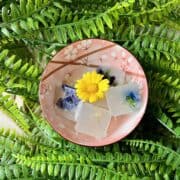Agar Agar Jelly (2-ingredient)
Calories: 222kcal
Equipment
- Pot
- Heat proof whisk
- Silicone container, wide heat-proof container and/ or cookie cutters
Ingredients
- 0.35 oz agar agar powder 10g. Substitute: agar agar flakes or agar agar strips. Soften in the water for 5-10 minutes before switching on the heat. You can also use konnyaku (but note it's a choking hazard) or gelatine (if not vegan.)
- 4.2 Cups coconut water (1 litre/ 0.264 US gallons.) This can be either fresh or from the bottle. For this recipe, I used bottled coconut water to make the agar agar jelly before setting it in a real coconut husk. (Note: your brand of agar agar powder may require a different amount of liquid to set- check before starting!) You can substitute with water but it'll be super bland without a sweetener. If adding sugar, whisk the sugar with the agar powder before pouring into the liquid. (This prevents clumping.)
- Cut-up fruits Optional. If you want to make the jelly sweeter without adding sugar, add some fruits into the agar agar before it sets.
Instructions
- Pour the cold/ room temperature coconut water into the pot, add the agar agar powder then stir to dissolve. The heat is not on yet.
- Switch on the fire to medium heat, bring the solution to the boil, whisking continuously.
- Stil till all the powder has dissolved, let it fullyboil for 5 minutes, then switch off the fire.
- Agar agar sets quickly at room temperature. Hence, if you are adding fruits, stir them into the agar agar now before it has set, making sure to stir such that the fruits are well-distributed. Note that the heat will make the fruits soften and affect their texture a little.
- Pour the jelly into the designated containers/ molds to set. Optional: cut out shapes with cookie cutters once hardened. (It sets at room tempeature but tastes nice cold, especially when the weather is hot out!)Tip: If you're entertaining, it's a nice touch to pour the jelly into coconut husks. (Leave the coconut flesh in the coconut for a nice contrast in texture.) Do make sure to choose smaller coconuts and not to pour all the way to the brim, or it will be too big of a portion for 1 person!
Notes
Never add agar agar directly to warm/ hot water as the powder will immediately form indissoluble clumps. Always use cold or room temperature water.
Other liquids: If you decide to experiment with the liquid used, be careful if using citrus fruits and acidic liquids as acidity impacts the ability of agar to set. For example, you will need more agar agar powder with orange juice and lemon. (Approximately 13g of agar agar powder to 1 litre of juice.)
Some raw fruit juices won't set and you'll need to cook them first. These include kiwi, pineapple, fresh figs, mango, papaya and peaches. (Canned fruits are pre-cooked and work OK.)
Changing the texture: You can add up to 20% more water for softer, wobblier jellies. (Personally, I like firmer jellies, like konnyaku, which is very bouncy!) If you add too much water, the agar jelly won't set. Don't fret. Just add more agar powder and bring the mixture to the boil again. (I had to do this the first time I made mango jelly!)
Note: the nutritional information is an estimate automatically calculated using the WPRM recipe maker and I am not responsible for its accuracy.
Nutrition
Calories: 222kcal | Carbohydrates: 45g | Protein: 8g | Fat: 2g | Saturated Fat: 2g | Polyunsaturated Fat: 0.03g | Monounsaturated Fat: 0.1g | Sodium: 1069mg | Potassium: 2632mg | Fiber: 12g | Sugar: 27g | Vitamin C: 24mg | Calcium: 304mg | Iron: 5mg
